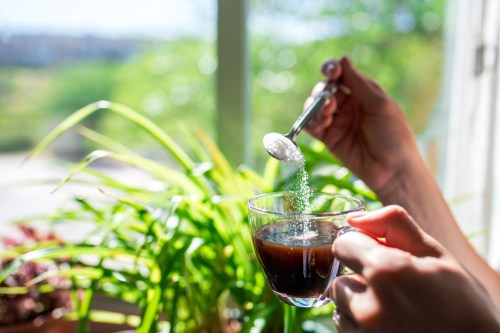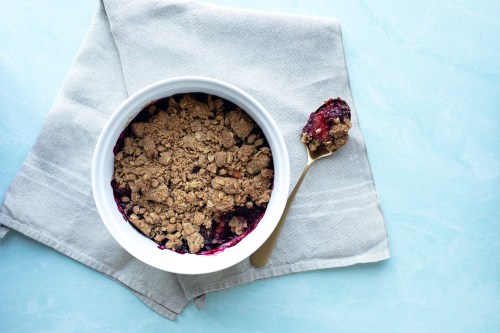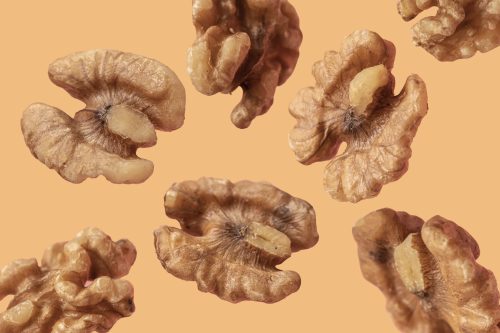Our editors independently select these products. Making a purchase through our links may earn Well+Good a commission
Move Over Stevia—Monk Fruit is Here to Stay
As wellness trends move away from more commercially-available artificial sweeteners, monk fruit continues to fully stake a claim in the sweetener world.

Praised for being 150 to 200 times sweeter than sugar, this Southeast Asian fruit seems to be in almost every single new packaged food product lately, from candies to bottled coffees to baked goods.
But, it’s not exactly new: Jessica Cording, R.D., says that she first saw monk fruit extract around 2017, around the time when the Paleo diet became popular, and people began to seek out alternative sugars that weren't lab-made. (We’ve actually been talking about it here at Well+Good since 2016.) Ever since, the sweetener has billed itself as a natural sugar alternative rivaling other popular choices like Splenda and stevia. And it has a lot going for it: It’s a plant-based option (like stevia), isn’t associated with side effects like blood sugar spikes, and some research has shown that it may have antioxidant properties, too.
However, as interest in low-carb eating plans like keto has surged and the world is getting more and more mindful of the potential effects of excessive sugar consumption, monk fruit seems to have beaten the likes of erythritol, stevia, and Splenda to be the alt sweetener du jour. It’s popping up as a selling point on healthy products, was a major buzzword at ExpoWest 2025, and is fueling some interesting innovation in the food space. But how did the ingredient come out on top in the midst of a very crowded field?
How did monk fruit get so popular?
One huge reason: Taste. Some alternative sweeteners offer a distinct aftertaste; monk fruit, by comparison, has a slightly more neutral palate. “Many of our customers have a strong aversion to the flavor and aftertaste [of stevia]. Monk fruit helps strike the right balance of flavor and nutritional profile, while staying natural,” says Maggie Luther, former medical director of now defunct nutrition company Care/of.
Tero Isokauppila, founder and CEO of Four Sigmatic, says he came across monk fruit about 10 years ago as he was searching for a natural sweetener to balance out bitter mushroom extracts. “I’ve been playing with it in recipes for the last six years,” he says. “Consumers are also demanding stevia-free protein powders, so this was monk fruit’s time to shine.” Four Sigmatic combines monk fruit extract, organic lucuma, and organic coconut palm sugar to round out the flavor profile of their plant-based Superfood Protein Powder ($40), he says.
Other brands are hoping monk fruit will help their customers avoid some of the more negative side effects of other sweeteners—Splenda, for example, can cause bloating and even have a laxative effect if eaten in excess, says Cording. Lauren Picasso, the founder of Cure Hydration, says she chose monk fruit to sweeten her brand’s recovery and hydration powders in part because artificial sweeteners (like sucralose and aspartame) may negatively affect your gut health.
Interestingly, Cure pairs it with stevia rather than avoiding it because “stevia has a sweeter taste but a stronger aftertaste than monk fruit...we use a blend to balance the sweetness and flavor,” Picasso says. “Monk fruit is also very difficult to grow and export, and as result can be very expensive.” The result: A naturally-flavored electrolyte mix that can be stirred into water and costs less than $2 per serving.
“Consumers are demanding stevia-free protein powders, so this was monk fruit’s time to shine.” —Tero Isokaupppila, founder and CEO of Four Sigmatic
Similarly, low-sugar cereal brand Magic Spoon ($39 for 4 boxes) came to monk fruit after over a year of experimentation, says co-founder Gabi Lewis. The brand was looking to reimagine childhood cereal favorites but with more protein and way less carbs and sugar. He says they wanted to stay away from sugar alcohols like erythritol, which can result in bloating, so his team taste-tested more natural options from coconut nectar to monk fruit to the keto-friendly yacon syrup.
Since sweetness is paramount to any classic breakfast cereal (even one that’s more health-minded!), Lewis says they landed on three natural sweeteners: monk fruit, stevia, and allulose. “Each of these sweeteners on its own can produce a slight aftertaste," he says. "By blending them together in specific ratios, we’re able to balance the notes and flavors and create a sweetness that most closely resembles regular sugar."
How much monk fruit is ok to consume?
Of course, monk fruit has its limitations. Cording adds that using too much of any kind of sweetener (sugar, monk fruit, or otherwise) can make it harder for a person to appreciate naturally occurring sweetness in foods. And because they don’t have calories, sweeteners create a “health halo,” so that you may eat more than you would if the food contained straight-up sugar. “The goal should be to consume fewer added sweeteners, whether it’s monk fruit or others, and to celebrate natural sweetness of foods we’re eating,” says Cording. "Choose whichever sweetener you’ll be most satisfied in smallest amount.”
However, for people who want to (or need to) limit their sugar intake, healthier sweeteners like monk fruit can be game changers. Khuyen Dinh, Well+Good's editorial assistant, who attended this year's ExpoWest, noted that "The next gen of artificial and low calorie sweeteners are here as people continue to look for ways to cut back on sugar without giving up sweetness." As monk fruit is seen as a more "natural" option, Dinh notes that they're "perfect for the wellness-minded consumer."
In Cording’s view, there is absolutely no replacement for whole foods sources of sweetness—and that’s a goal everyone can aim towards. But if you’re looking to have your low-sugar cake and eat it too…you’re likely in good hands with monk fruit.
How to use monk fruit sweetener at home
For beverages, like your morning coffee or tea, monkfruit sweetener is an easy 1:1 swap with your regular option. In fact, it's so sweet that you'll often need less than you would of sugar, honey, or even stevia. Same goes for the pinch of sugar you're adding to your barbecue sauce, or the half teaspoon you need for caramelizing onions—any place where sugar would be fully dissolved and used *just* as a sweetener is totally fine to swap the way you would with any other sugar substitute.
For baking, the internet is divided. Some bakers say it's a totally fine swap, especially in a merengue where sugar is supposed to be crystalized. Other say their cake turns a weird color. Like with any substitutes, especially with science-forward baking, it's best to play around and do trials and tests with your recipe before committing to it.










